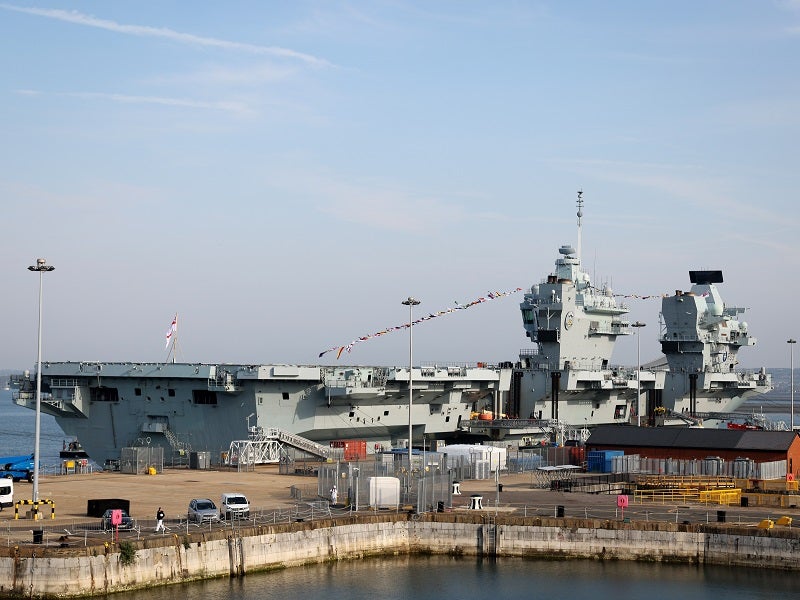
The departure of the UK’s troubled aircraft carrier HMS Prince of Wales for drydock inspection and repairs has been delayed due to diving work being undertaken on the vessel’s starboard shaft as the Royal Navy prepares the 65,000-tonne carrier for its transit to Rosyth, Scotland.
It had been expected that the vessel would depart from Portsmouth Naval Base for Babcock’s drydock facility in Rosyth, however this this has now been put back. Information updates on the Royal Navy’s Kings Harbour Master’s movements site indicates persistent diving work taking place on HMS Prince of Wales.
In a statement, a Royal Navy spokesperson said: “HMS Prince of Wales is preparing to sail to Rosyth to undergo repairs to her right propellor shaft. The full extent of the repairs will be known once the ship has entered dry dock. We are committed to getting HMS Prince of Wales back on operations, protecting the nation and our allies, as soon as possible.”
Weather is also a factor in ensuring HMS Prince of Wales is able to make the journey, which would take the vessel up and along the east coast of Great Britain and into the Firth of Forth.
The move to drydock is intended to identify and fix issues related to the carrier’s starboard propellor shaft, which on 27 August brought the vessel’s intended Atlantic crossing to participate in exercises off the US eastern seaboard to a sudden halt.
HMS Prince of Wales has spent weeks alongside the Princess Royal Jetty, as engineers work with divers and naval architects from Babcock and the UK Ministry of Defence’s (MoD) Defence Equipment and Support organisation to determine how to bring the vessel back to operational capability.
How well do you really know your competitors?
Access the most comprehensive Company Profiles on the market, powered by GlobalData. Save hours of research. Gain competitive edge.

Thank you!
Your download email will arrive shortly
Not ready to buy yet? Download a free sample
We are confident about the unique quality of our Company Profiles. However, we want you to make the most beneficial decision for your business, so we offer a free sample that you can download by submitting the below form
By GlobalDataThe Prince of Wales’s 33-tonne starboard propellor has also been removed while alongside in Portsmouth ahead of its journey to the Babcock’s Rosyth dockyard in the Firth of Forth, meaning the vessel will transit under reduced movement on its port propellor alone, likely with assistance from sea-going tugs.
At this stage, it is unlikely a timescale for repairs has been fully mapped out, with greater inspections required when HMS Prince of Wales enters drydock.
However, should the worst fears be realised and the starboard propellor shaft be badly damaged or bent, repair work could take a considerable amount of time and effectively see the carrier unable to undertake operations for several months, potentially into the back end of 2023 or even 2024.
HMS Prince of Wales had been planned to participate in a series of flight exercises off the US coast in the same way as its sister ship HMS Queen Elizabeth had done previously.
As vessels of the same class, the Prince of Wales and Queen Elizabeth are effectively twins, although the former has integrated lights to enable Shipborne Rolling Vertical Landing operations that allows F-35B stealth fighter, which normally land vertically, to land on glide slope and thus avoiding having to dump munitions into the sea.
A ship with issues
This is not the first time that HMS Prince of Wales has suffered a significant engineering issue. In 2020 the vessel’s engine room flooded following a fire system malfunction, which by coincidence also delayed a planned Atlantic crossing.
The sister ship, HMS Queen Elizabeth, by contrast undertook a global deployment in 2021, operating in the Mediterranean, Indian Ocean, and Asia-Pacific region, fully integrating a US Marine Corps F-35B unit alongside its own embarked air wing. HMS Queen Elizabeth also split from its own exercise programme this month to deputise for the Prince of Wales as host vessel for the Atlantic Future Forum in New York Harbour.







